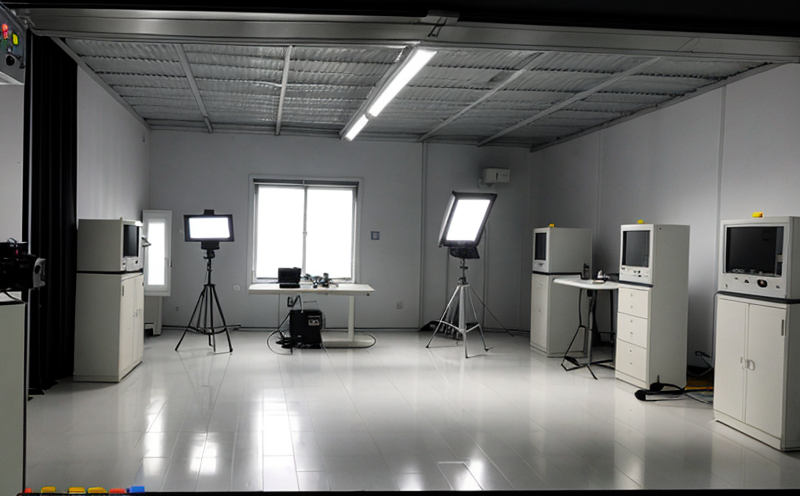CIE 112 Glare Evaluation in Photometric Testing
The CIE Standard No. 112 provides a methodology for evaluating the glare potential of luminaires and light sources based on visual discomfort and annoyance under defined conditions. This standard is particularly important in lighting design, as it ensures that products meet safety and comfort requirements while enhancing user satisfaction.
The test involves measuring the spatial distribution of light intensity from a luminaire or lamp and analyzing its effect on human vision when viewed against various background luminance levels. The primary goal is to quantify how much discomfort or annoyance might be experienced by an observer under typical usage conditions. This helps manufacturers design products that are both functional and comfortable for users.
The process begins with precise photometric measurements using a PMS. These systems capture the full spatial distribution of light intensity, including directionality and angular distribution, which is crucial for accurate glare assessment. The data obtained from these tests are used to simulate viewing conditions under different background luminances.
The CIE 112 evaluation considers several parameters that influence glare perception, such as the angle between the direct and reflected beam, the brightness of the light source relative to the background, and the size of the light source in relation to the observer's field of view. By analyzing these factors, the standard provides a numerical index known as the GSI, which quantifies the likelihood and severity of glare.
This evaluation is not only important for ensuring compliance with regulatory standards but also for improving product design. For instance, it allows manufacturers to adjust the cutoff angle of a luminaire or modify its reflector geometry to reduce unwanted glare. Additionally, it aids in optimizing light distribution patterns that enhance visual comfort and safety, particularly in environments where visibility is critical.
The CIE 112 methodology ensures that lighting products are evaluated under controlled conditions that mimic real-world scenarios. This approach helps in identifying potential issues early in the design process, leading to more robust and user-friendly products. Furthermore, it supports the development of lighting solutions that contribute positively to human well-being by minimizing discomfort and maximizing visual performance.
Understanding the nuances of CIE 112 is essential for professionals in various fields, including quality management, compliance officers, R&D engineers, and procurement personnel. These stakeholders can leverage this knowledge to make informed decisions about product selection, design improvements, and regulatory compliance.
Benefits
Evaluating glare using CIE 112 offers numerous benefits that enhance the overall quality and user experience of lighting products:
- Improved Compliance: Ensures adherence to international standards, which is crucial for market access and regulatory compliance.
- User Comfort: Reduces visual discomfort and annoyance by optimizing light distribution patterns.
- Safety Enhancement: Minimizes the risk of accidents caused by poor visibility in critical environments.
- Aesthetic Appeal: Enhances the aesthetic design of luminaires, making them more visually appealing to consumers.
- Cost Efficiency: By identifying and resolving glare issues early in the development process, manufacturers can reduce rework costs.
- Sustainability: Designing for reduced glare contributes to a greener environment by promoting efficient energy use and reducing light pollution.
In summary, CIE 112 evaluation is a vital tool that supports the creation of lighting products that are safe, comfortable, and visually pleasing. This ensures that users can enjoy the benefits of well-designed lighting without experiencing discomfort or annoyance.
Industry Applications
The application of CIE 112 glare evaluation is broad and covers various industries where lighting plays a critical role:
- Commercial Buildings: Ensures that office spaces, retail environments, and other commercial settings provide optimal visual comfort and safety.
- Residential Lighting: Improves the aesthetic appeal and usability of home lighting systems, contributing to a better quality of life for residents.
- Transportation: Enhances visibility in roadways, tunnels, and other transportation facilities, reducing accidents and improving safety.
- Hospitality: Ensures that hotels, restaurants, and other hospitality venues provide comfortable lighting that enhances the customer experience.
- Sports Facilities: Optimizes lighting conditions for athletes and spectators in stadiums and arenas to ensure peak performance.
In each of these applications, CIE 112 plays a crucial role by providing a standardized method to evaluate glare potential. This ensures that lighting products are not only functional but also safe and visually comfortable for all users.
Environmental and Sustainability Contributions
- Energy Efficiency: By reducing glare, lighting systems can be designed more efficiently, leading to lower energy consumption. This contributes to a reduction in greenhouse gas emissions.
- Light Pollution Reduction: Properly designed lighting products with minimized glare help reduce light pollution, preserving natural darkness and supporting ecosystems.
- Sustainable Design: Incorporating CIE 112 evaluation into the design process promotes sustainable practices by ensuring that lighting solutions are both functional and environmentally responsible.
The CIE 112 methodology supports a more sustainable approach to lighting design, contributing to environmental conservation efforts. By minimizing unnecessary light emission and optimizing visual comfort, this standard plays a vital role in creating a greener future.





